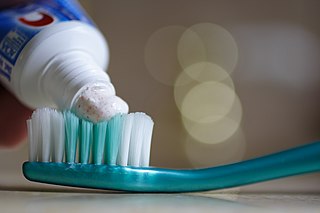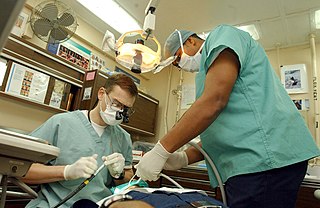
A dentist, also known as a dental surgeon, is a surgeon who specializes in dentistry, the diagnosis, prevention, and treatment of diseases and conditions of the oral cavity. The dentist's supporting team aids in providing oral health services. The dental team includes dental assistants, dental hygienists, dental technicians, and sometimes dental therapists.
Dental sealants are a dental treatment intended to prevent tooth decay. Teeth have recesses on their biting surfaces; the back teeth have fissures (grooves) and some front teeth have cingulum pits. It is these pits and fissures which are most vulnerable to tooth decay because food and bacteria stick in them and because they are hard-to-clean areas. Dental sealants are materials placed in these pits and fissures to fill them in, creating a smooth surface which is easy to clean. Dental sealants are mainly used in children who are at higher risk of tooth decay, and are usually placed as soon as the adult molar teeth come through.
The Texas A&M College of Dentistry, located in Dallas, Texas, United States, is the dental school of Texas A&M University and is a component of the Texas A&M Health Science Center. Almost two-thirds of all the dentists in the Dallas–Fort Worth metroplex received their education at the College of Dentistry, and more than one-third of all dentists in Texas are graduates of the college. It is the largest single provider of oral health care services in the Metroplex.

A dental hygienist or oral hygienist is a licensed dental professional, registered with a dental association or regulatory body within their country of practice. Prior to completing clinical and written board examinations, registered dental hygienists must have either an Associate's or Bachelor's degree in Dental Hygiene from an accredited college or university. Once registered, hygienists are primary healthcare professionals who work independently of or alongside dentists and other dental professionals to provide full oral health care. They have the training and education that focus on and specialize in the prevention and treatment of many oral diseases.

Dental fluorosis is a common disorder, characterized by hypomineralization of tooth enamel caused by ingestion of excessive fluoride during enamel formation.
The UCLA School of Dentistry is the dental school of the University of California, Los Angeles (UCLA) located in the Center for Health Sciences building in the Westwood neighborhood of Los Angeles, California, United States. The school has several educational and training programs, conducts oral and dental health research, and offers affordable dental care at three locations: Westwood, Venice, and Inglewood. The school also participates in several outreach endeavors, including numerous health fairs during the year, STEM pipeline programs and provides dental care for underserved populations in the region. The School of Dentistry is considered among the nation's best research-intensive dental schools.
The University of Pittsburgh School of Dental Medicine is the dental school of the University of Pittsburgh (Pitt). It is located in Pittsburgh, Pennsylvania, United States. It is one of Pitt’s six schools of the health sciences and one of several dental schools in Pennsylvania. It is closely affiliated with the University of Pittsburgh Medical Center. The School of Dental Medicine accepted 3.6% of applicants for the class of 2016, a record low for the school's entire history.

Early childhood caries (ECC), formerly known as nursing bottle caries, baby bottle tooth decay, night bottle mouth and night bottle caries, is a disease that affects teeth in children aged between birth and 71 months. ECC is characterized by the presence of 1 or more decayed, missing, or filled tooth surfaces in any primary tooth. ECC has been shown to be a very common, transmissible bacterial infection, usually passed from the primary caregiver to the child. The main bacteria responsible for dental caries are Streptococcus mutans and Lactobacillus. There is also evidence that supports that those who are in lower socioeconomic populations are at greater risk of developing ECC.

Dental assistants are members of the dental team. They may support a dental operator in providing more efficient dental treatment. Dental assistants are distinguished from other groups of dental auxiliaries by differing training, roles and patient scopes.
A dental auxiliary is any of the dentist's supporting team who helps with dental treatment. They include dental assistants, dental therapists, dental hygienists, dental technologists, and orthodontic auxiliaries. The role of dental auxiliaries is usually limited by regional dental regulations, which help define the boundaries of treatment that can be performed.
A dental therapist is a member of the dental team who provides preventative and restorative dental care, usually for children and adolescents. The precise role varies and is dependent on the therapist's education and the various dental regulations and guidelines of each country.
Dental Public Health (DPH) is a non-clinical specialty of dentistry that deals with the prevention of oral disease and promotion of oral health. Dental public health is involved in the assessment of key dental health needs and coming up with effective solutions to improve the dental health of populations rather than individuals.
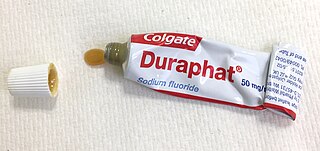
Fluoride varnish is a highly concentrated form of fluoride which is applied to the tooth's surface, by a dentist, dental hygienist or other health care professional, as a type of topical fluoride therapy. It is not a permanent varnish but due to its adherent nature it is able to stay in contact with the tooth surface for several hours. It may be applied to the enamel, dentine or cementum of the tooth and can be used to help prevent decay, remineralise the tooth surface and to treat dentine hypersensitivity. There are more than 30 fluoride-containing varnish products on the market today, and they have varying compositions and delivery systems. These compositional differences lead to widely variable pharmacokinetics, the effects of which remain largely untested clinically.
Special needs dentistry, also known as special care dentistry, is a speciality of dentistry concerned with the oral health of people who have intellectual disability, or who are affected by other medical, physical, or psychiatric issues.
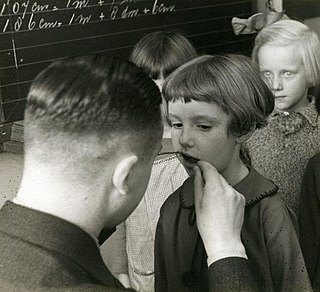
Pediatric dentistry is the branch of dentistry dealing with children from birth through adolescence. The specialty of pediatric dentistry is recognized by the American Dental Association, Royal College of Dentists of Canada, and Royal Australasian College of Dental Surgeons.
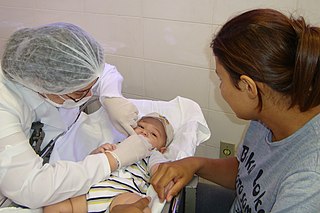
Dentistry for babies is a branch of Pediatric dentistry related to the dental treatment provided to children from birth to around 36 months of age, aiming to maintain or re-establish a good oral health status, at the same time as it creates a positive attitude of parents and children about Dentistry. Although concerns about dental treatment directed to babies have been reported at the beginning of the twentieth century, only recently the dental community started to focus on this area of Dentistry, due to the high dental caries (decay) prevalence observed in young children. The first setting for providing dental care exclusively to babies started in 1986, at Londrina's State University (Brazil), changing the concept from early treatment of carious lesions and their consequences to early educative-preventive attention. These concepts were disseminated through the entire country introducing new clinics with a similar philosophy such as the Baby Clinic of Araçatuba Dental School, São Paulo State University (UNESP), and also abroad.
ReachOut Healthcare America (RHA) is a dental management services company with its headquarters in Farmington Hills, Michigan. It is a part of the private equity portfolio of Morgan Stanley. The company operates in 22 U.S. states. In 2011 the company coordinated dental care at 8,700 schools and coordinated the processing of 488,000 children in those schools. As of May 2012 the company has coordinated the processing of 1.5 million patients. ReachOut seeks to coordinate treatment for underserved children on Medicaid.

Tooth pathology is any condition of the teeth that can be congenital or acquired. Sometimes a congenital tooth diseases are called tooth abnormalities. These are among the most common diseases in humans The prevention, diagnosis, treatment and rehabilitation of these diseases are the base to the dentistry profession, in which are dentists and dental hygienists, and its sub-specialties, such as oral medicine, oral and maxillofacial surgery, and endodontics. Tooth pathology is usually separated from other types of dental issues, including enamel hypoplasia and tooth wear.
Esther Mae Wilkins was an American dental hygienist, dentist and author of the first comprehensive book on dental hygiene, Clinical Practice of the Dental Hygienist. The dental instrument known as the Wilkins/Tufts Explorer was named after her.
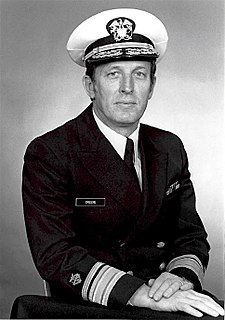
John C. Greene was an American dentist and public health administrator. He was a rear admiral in the U.S. Public Health Service Commissioned Corps, and served as the Deputy Surgeon General of the United States under President Carter from 1978 to 1981. He was the Acting Surgeon General from January to May 1981 under Ronald Reagan. He was the highest ranking non-physician public health officer in the history of the U.S. government.

